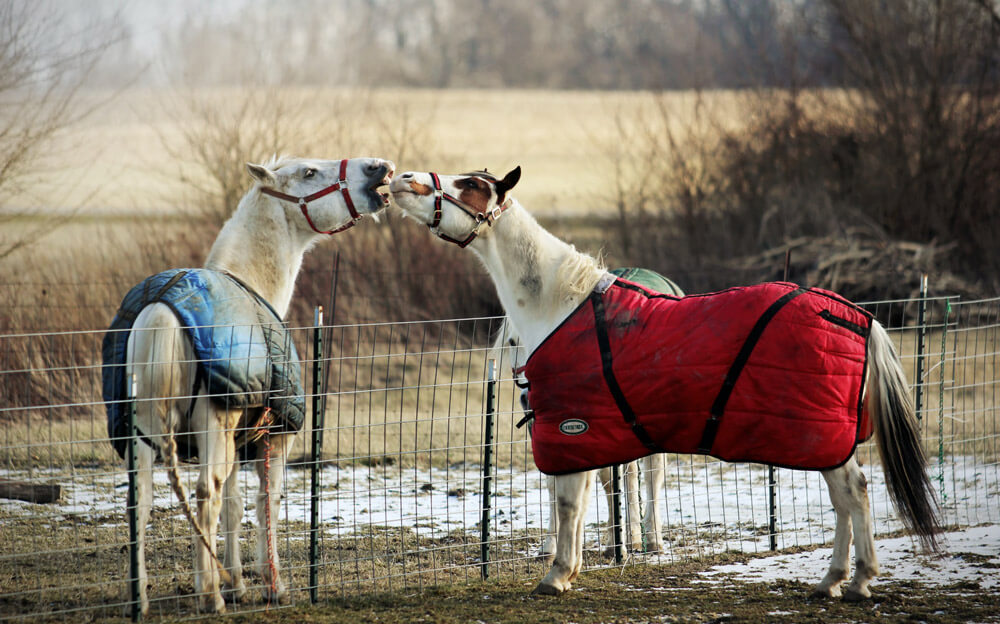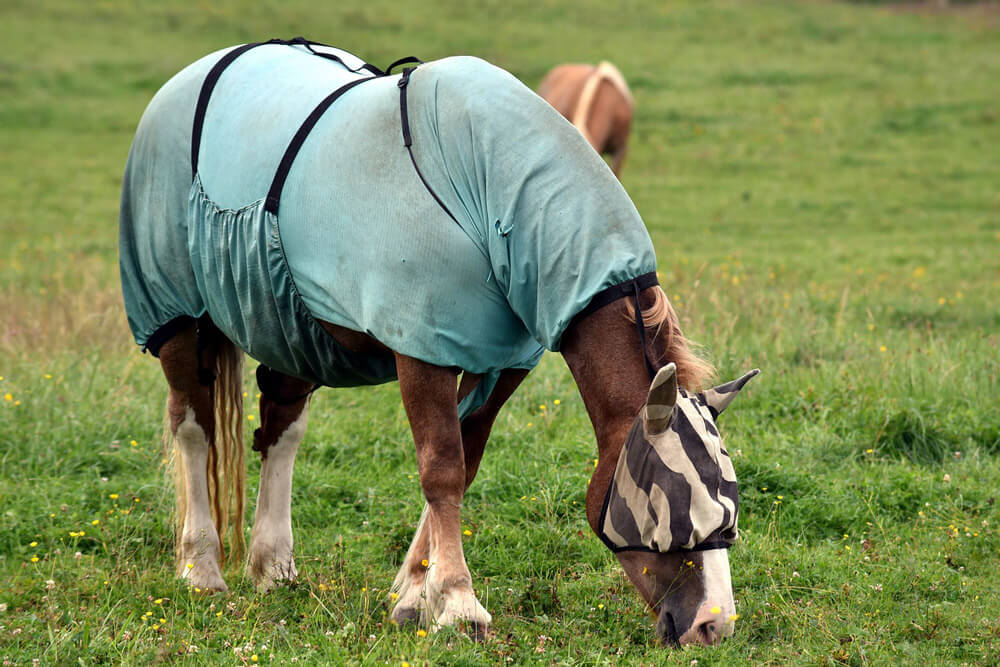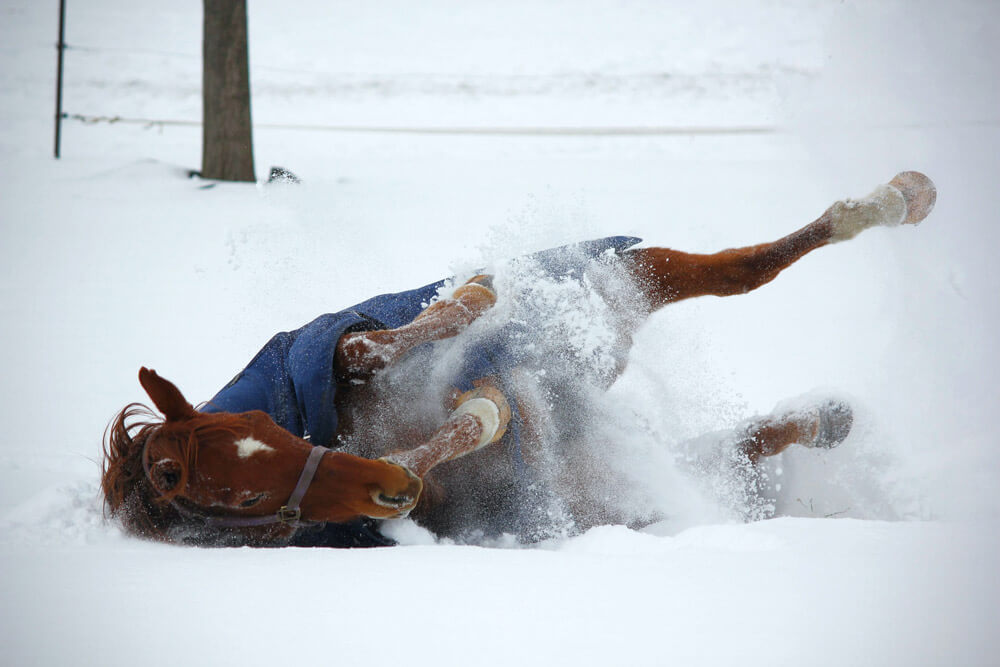When another fall is coming, a horse owner is getting puzzled with a question: “To blanket or not to blanket?”. Dozens of horse blanket types are available with different styles and thicknesses to be chosen. Thus, we prepared these horse blanketing guidelines to explain when to blanket a horse.

Does My Horse Need a Blanket?
In fact, horses have a natural ability to withstand cold weather conditions. They look for a proper shelter to hide from snow, rain, and wind. Horses are able to produce body heat in order to live comfortably during rough weather. Thus, horse owners may be wondering whether or not to blanket their horses.
As a matter of fact, you should decide if a blanketing is suitable for your horse. A few advantages, as well as disadvantages, may follow the covering of your companion.
- Blanketing is a good option for showing horses. Covering the horse helps to slow down the hair growth as the temperature under the blanket is rather warmer than outside. Hence, grooming your horse would take less time with shorter hair. That’s why a horse blanket is a go-to apparel for show horses during cold seasons.
- Additionally, a horse blanket helps you to keep your horse neat and dry when it’s outside the shelter. Most horse sheets are water-resistant, which is a great perk. So you can easily clean the blanket, quick-dry, and use it again.
- Another perk of covering a horse is that a sheet can keep the warm for long. In case of heavy rain or snow, if there’s no hiding spot nearby, a winter horse blanket will come in handy for sure. Or if you need to transfer your companion and provide a comfy environment, again, use a blanket.
- If you recently moved to another region with a much cooler climate, your horse needs some time to get used to it. Blanketing could make the adaptation process much more convenient.
- A horse rug can be used for old and sick horses in order to help them regulate body temperature. Besides, it could protect them from insect biting and sunlight.
- A pregnant mare can also get covered with a blanket in order to keep warm if she’s frequently turned out.
On the other hand, it’s up to you, blanket or not to blanket a horse. Keep in mind that covering a horse with a sheet reduces the winter hair growth that is essential to produce the body heat. Apart from that, watch your companion doesn’t get too hot. It could affect the state of health, especially during the winter period.

Horse Blanket Types
If you decide to try a horse sheet, you should know that there are different types of them. Each design is made to fit the specific need. Thus, it’s crucial to know not only when to blanket a horse, but also which type of sheet to use. Here’s a list of the common horse blanket types:
- Coolers. It’s a popular sheet that will stand you in good stead for sure. Such blankets are made with a thick wool lining that has a good moisture-wicking feature. The sheet is obviously used to help to dry out your horse. Additionally, the gear keeps the warm immensely, so it keeps your companion from freezing.
- Fly Sheets. As its name implies, the gear is used to protect your horse from insect biting. The blanket is worn when the horse is outside the barn at the open space. This design is specially made for warm seasons, as it’s thin and doesn’t have inlining. In addition, a fly sheet has UV protection from overheating the horse.
- Quarter Sheets or an Exercise Rug. It’s a riding blanket that has a different design. The gear doesn’t cover the full body, it’s only worn on the horse’s hindquarters. There are two types of exercise rug. The first one serves for keeping your horse dry while you’re riding in rainy weather. It’s made with a sturdy waterproof material that wicks the moisture. The second type of a riding blanket comes with a thick and soft lining, generally made of wool or fleece. This is made to keep your horse warm while training in cold weather. That’s a great feature in order to avoid the rapid temperature leap. When your horse is coming out from the warm barn to the cold open air paddock, the sheet helps to get used to the new location gradually and comfy.
- Rain Sheets. As you have already guessed, the rain sheet is a sort of raincoat for people. It’s made of waterproof materials to withstand wet weather conditions outside. The sheet is thin with no lining, so it doesn’t wick water. Additionally, the rain sheet can be put over the stable sheet if you need to make the last one water-resistant.
- Stable Blankets. This type is commonly used to keep the horse comfy inside the barn. And it provides extra warmth if you feel your companion is getting cold outside. Mind that stable blankets may not provide water resistance if you’re planning to use the apparel out of the shelter. Besides, the product comes in different weights – light, medium, and heavy – to hit various heating levels undercover.
- Turnout Blankets. The sheet has a similar design as a stable blanket but there’s a waterproof feature as well. They are made with solid materials to withstand rough weather conditions and horseplay at the paddock. On the contrary, a turnout blanket is quite breathable to help regulate the horse body temperature duly. In cold weather, this soft sheet keeps the horse warm and cozy.
As you can see, there are loads of options available to suit any taste. A horse blanket is quite a versatile sheet that can be used for different purposes and in all weather conditions, which is an awesome plus.

When to Blanket a Horse: Horse Blanketing Guidelines
Lots of aspects may affect your decision about whether to blanket your horse or not. Thus, we made up the following horse blanketing guidelines to get it straight when to blanket a horse.

Body Hair Condition
As we already mentioned, blanketing affects hair growth. That’s why depending on the purpose you follow, you may or may not need to cover your companion with a winter horse blanket.
If your horse is healthy and treated properly, and you’re not going to clip it in winter, your companion is likely to not need a blanket. As these animals can produce the proper body temperature to withstand cold weather. The hair starts to puff up and keeps the warmth needed. However, if you’re riding in a wet climate with frequent rains, the horse sheet should be considered.
As for trace-clipped horses, the hair is removed from the chest, under the neck and belly. So the horse stays “half-clipped” in order to avoid excessive sweating while riding but still, there’s some hair left to keep the warmth. Blanketing is recommended in this case but it’s not vital. As the main body parts as the neck, shoulders, and back are still warmed up.
When you full-clip your horse, you get rid of the hair from almost the entire body. Generally, the lower legs are left unclipped as well as the spot on the back where a horse saddle is geared up. In this case, the coat doesn’t provide enough natural heating, thus, blanketing is needed. Depending on the temperature, you may need a horse sheet of different thicknesses.
Here’s a horse blanket chart to help you choose the proper sheet type.
| Temperature (°F) | Unclipped Horse | Trace-Clipped Horse | Full-Clipped Horse |
|---|---|---|---|
| <55 | — | — | sheet or light |
| <45 | — | sheet or light | medium + neck cover |
| <35 | — | medium | heavy + neck cover |
| <25 | — or medium | heavy | heavy + sheet or liner + neck cover |
| <15 | medium | heavy + sheet or liner | heavy + sheet or liner + neck cover |

How Thick a Horse Blanket Should Be
Checking the horse blanket chart above you may notice different sheet types in terms of thickness. A horse blanket can be light, medium, and heavyweight, so what’s the difference?
- A lightweight horse blanket protects from rain and wind but it doesn’t provide much warmth. It comes with 0 to 150 grams of polyfill.
- A medium horse blanket is good for a stable that provides some level of warmth. It comes with 150 to 200 grams of polyfill.
- A heavy horse blanket is a waterproof cover suitable for a turnout that protects from rain and wind. It comes with 200 to 250 grams of polyfill.
- A super-heavy horse blanket is a solid winter horse blanket that provides great heating. It comes with 250 to 300 grams of polyfill.
Therefore, mind the climate you live and ride in as well as weather conditions, and you may pick the best horse blanket for your horse.
Here’s another useful horse blanket chart that exhibits a detailed guide on blanketing a horse.


How to Choose the Right Horse Blanket Size
When you choose the type of horse sheet that is suitable for your companion, it’s time to get the proper size. So how to pick a proper horse blanket size?
You need a regular fabric tape to take the measurements of your horse. To find your horse blanket size you need to measure starting from the horse’s chest (in the middle as it’s shown in the chart below) and going to the rear of the hind legs. You’re likely to need help in this process.
Compare your results with a sizing chart that is commonly provided by the manufacturer. Choose the product that fits best, and don’t pick the blanket that will sit too tight or loose.


Final Thoughts
Blanketing a horse is an optional choice for every horse owner. It’s up to you whether or not your companion needs extra heating. If you decided to cover your horse with a sheet or not, think wisely which horse blanket size and type it needs. Depending on the weather condition, you may need a sheet of various weights. Follow the horse blanket chart provided in this article to find a perfect match for your little friend. Stay warm!
Image Source: doversaddlery.com, shutterstock.com, unsplash.com, pixabay.com.
